
The Lanchester 10, or Lanchester Ten, is a model of car that was produced by the Lanchester Motor Company intermittently from 1900 until 1951. It was the first production car offered for sale by the company.

The Lanchester 10, or Lanchester Ten, is a model of car that was produced by the Lanchester Motor Company intermittently from 1900 until 1951. It was the first production car offered for sale by the company.
The name referred to the car's fiscal horsepower, which was a function of the cylinder diameter. Fiscal horsepower was used in the UK, as in other European countries, by government to determine how much tax they would levy on the cars’ owners. It was differently defined in each country: the common feature was that there was no arithmetical correlation between tax horsepower and actual horsepower.
Fiscal horsepower categories were used to name cars in many parts of Europe until well into the 1950s, and they effectively defined the class within which the car competed. Thus a Lanchester Ten from the 1950s was approximately the same size as the Ford Model C Ten, the Morris Ten, the Standard Ten and a plethora of cars from other manufacturers carrying the "Ten" name during the same period.
| Lanchester 10 (1900–1904) | |
|---|---|
| Overview | |
| Manufacturer | Lanchester Motor Company |
| Production | 1900–1904 |
| Designer | Frederick Lanchester |
| Body and chassis | |
| Body style | Individually coachbuilt |
| Powertrain | |
| Engine | 4,033 cc (246.1 cu in) twin-cylinder air-cooled |
| Dimensions | |
| Wheelbase | 93 in (2,400 mm) [1] |
The original Lanchester 10 was introduced in 1900, and was designed by Frederick Lanchester, the eldest of the three Lanchester brothers, while the third brother, George, took responsibility for designing the production processes.

Horsepower (hp) is a unit of measurement of power, or the rate at which work is done, usually in reference to the output of engines or motors. There are many different standards and types of horsepower. Two common definitions used today are the mechanical horsepower, which is about 745.7 watts, and the metric horsepower, which is approximately 735.5 watts.
The tax horsepower or taxable horsepower was an early system by which taxation rates for automobiles were reckoned in some European countries such as Britain, Belgium, Germany, France and Italy; some US states like Illinois charged license plate purchase and renewal fees for passenger automobiles based on taxable horsepower. The tax horsepower rating was computed not from actual engine power but by a mathematical formula based on cylinder dimensions. At the beginning of the twentieth century, tax power was reasonably close to real power; as the internal combustion engine developed, real power became larger than nominal taxable power by a factor of ten or more.

The Daimler Company Limited, before 1910 known as the Daimler Motor Company Limited, was an independent British motor vehicle manufacturer founded in London by H. J. Lawson in 1896, which set up its manufacturing base in Coventry. The company bought the right to the use of the Daimler name simultaneously from Gottlieb Daimler and Daimler-Motoren-Gesellschaft of Cannstatt, Germany. After early financial difficulty and a reorganisation of the company in 1904, the Daimler Motor Company was purchased by Birmingham Small Arms Company (BSA) in 1910, which also made cars under its own name before the Second World War. In 1933, BSA bought the Lanchester Motor Company and made it a subsidiary of the Daimler Company.

Frederick William Lanchester LLD, Hon FRAeS, FRS, was an English polymath and engineer who made important contributions to automotive engineering and to aerodynamics, and co-invented the topic of operations research.
The Lanchester Motor Company Limited was a British car manufacturer in active trade between 1899 and 1955. Though the Lanchester Motor Company Limited is still registered as an active company and accounts are filed each year, the marque has been dormant since. As of 2014 it is marked as "non-trading".
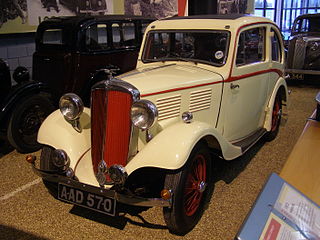
The Standard Ten was a model name given to several small cars produced by the British Standard Motor Company between 1906 and 1961. The name was a reference to the car's fiscal horsepower or tax horsepower, a function of the surface area of the pistons. This system quickly became obsolete as an estimate of the power produced by the engine, but it continued to be relevant as a way to classify cars for tax purposes. Like other manufacturers, Standard continued to use the name to define the approximate size of their 'Ten' model long after the origins of the name had, in Britain, become inapplicable.
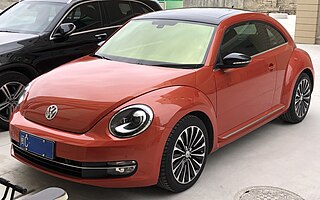
A car, or an automobile, is a motor vehicle with wheels. Most definitions of cars state that they run primarily on roads, seat one to eight people, have four wheels, and mainly transport people, not cargo. French inventor Nicolas-Joseph Cugnot built the first steam-powered road vehicle in 1769, while French-born Swiss inventor François Isaac de Rivaz designed and constructed the first internal combustion-powered automobile in 1808.

The Vauxhall 10-4 is a British-built small family car produced by Vauxhall between 1937 and 1947. It was launched at the October 1937 London Motor Show and was the first British car to have a unitary construction body. The first car was delivered to a customer on 1 November 1937.
George Herbert Lanchester was an English engineer. He was one of three brothers who played a leading role in the early development of the UK auto-industry.
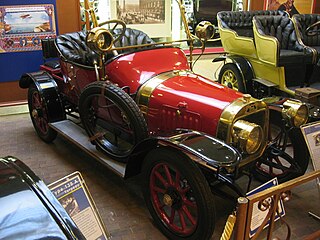
The Lion-Peugeot Type V4C3 was a motor car produced near Valentigney by the French auto-maker Lion-Peugeot between 1912 and 1913. It was the manufacturer's first car with a four-cylinder engine. 653 were produced.
The Lion-Peugeot Type VD was a motor car produced near Valentigney by the French auto-maker Lion-Peugeot in 1913. It was developed from the slightly smaller Lion-Peugeot Type V4C3 of the previous year. Approximately 800 Lion-Peugeot Type VDs were produced.
The Lion-Peugeot Type VD2 was a motor car produced near Valentigney by the French auto-maker Lion-Peugeot in 1915. It was usefully longer than the manufacturer's 1914 model, the Type V4D Approximately 480 Lion-Peugeot Type VD2s were produced. It was the last Lion-Peugeot produced before wartime economic conditions enforced the closure of Lion-Peugeot automobile production. Subsequent small Peugeots would be badged simply as Peugeots and produced in plants that had developed during the period, before 1910, when "Automobiles Peugeot" was a separate business.

The Daimler New Fifteen, was a large saloon/sedan car at the low end of the manufacturer's range, announced in September 1937. It had a tax rating of 16.2 hp. In September 1938 it was given a larger engine with the tax rating of 17.9 hp though it retained the name Fifteen. When production resumed in 1946 it was given a revised cylinder head, given chrome channel frames for the side windows, stripped of its running-boards, and renamed Daimler Eighteen.

The Lanchester Ten and Lanchester Eleven were sold by The Lanchester Motor Company Limited from the Ten's announcement in September 1932 until 1951. Quite different from previous Lanchesters, the Ten was the second of Lanchester's new owner's new Daimler-linked Lanchester range. The names Ten and Eleven referred to the engine's rating for the annual tax and did not relate to the engine's power output.

The Lanchester Light Six was a small luxury car in the twelve tax horsepower class manufactured for The Lanchester Motor Company Limited by BSA subsidiary The Daimler Company Limited. Announced in September 1934 it was the better-finished version of an almost identical pair the other half being the BSA Light Six

The Benz 10/25 PS was a midsize automobile introduced by Benz & Cie in 1912. The same year stated maximum output was increased which meant a name change to Benz 10/30 PS. The model disappeared for three years following the First World War but returned in 1921. A further power increase in 1926 meant another name change, now to Benz 10/35 PS. Following the "fusion" between the Daimler and Benz companies, production of the Benz 10/35 PS ended in 1927.
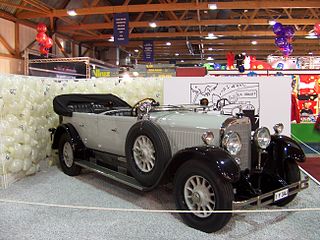
The Mercedes 15/70/100 PS was a large automobile introduced by Daimler in 1924. Production continued till 1929 by which time Daimler had merged with Benz & Cie as a result of which the car's name had changed to Mercedes-Benz Typ 400.

The Mercedes 24/100/140 PS was a large luxury car introduced by Daimler of Untertürkheim in 1924. Production continued until 1929 by which time Daimler had merged with Benz & Cie and the car's name changed to Mercedes-Benz Typ 630. The car was conceptually and structurally similar to the contemporary Mercedes 15/70/100 PS, but the 24/100/140 PS was longer, heavier, more powerful, faster and more expensive.

The Mercedes-Benz W02 was a midsize six-cylinder two-litre-engined automobile introduced by Daimler-Benz at the Berlin Motor Show in October 1926. It was developed in some haste under the manufacturer's Technical Director, Ferdinand Porsche in parallel with the smaller Mercedes-Benz W 01 and the larger three-litre-engined Mercedes-Benz W03 following the creation of Daimler-Benz, formally in July 1926, from the fusion of the Daimler and Benz & Cie auto-businesses.
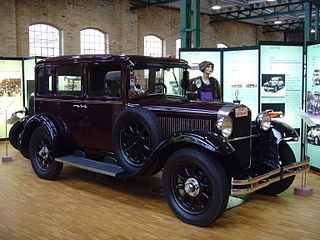
The Mercedes-Benz W11 was a midsize six-cylinder automobile introduced by Daimler-Benz it 1929. It was developed from the Mercedes-Benz W02 first seen in 1926, and the W11 shared its chassis and bodywork with the W02, but the W11 came with a larger more powerful engine, a new name and a wider list of “standard bodies” from which customers could choose.